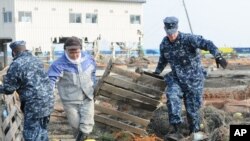The U.S. Navy has 14 ships off the coast of Japan, providing humanitarian assistance to victims of last week's earthquake and tsunami, and a command ship is expected in the area on Thursday. Some of the thousands of U.S. troops stationed in Japan are also involved in the relief effort.
At Japan's request, U.S. ships and their aircraft have delivered some 2,000 kilograms of food to the victims. In all, there have been more than 200 flights by U.S. helicopters and fixed-wing aircraft. In addition, American surveillance planes, including an advanced unmanned Global Hawk aircraft, are assessing the damage and looking for survivors.
Related video report by Elizabeth Lee
One U.S. ship picked up 273 Japanese troops and 93 of their vehicles in Hokkaido and is transporting them to the disaster zone. The ships are also serving as refueling stations for Japanese relief helicopters.
Two fire trucks were sent from a U.S. base to help fight fires at the damaged Fukushima Daiichi nuclear power plant. They are being operated by Japanese crews. The U.S. military provided additional hoses and water pumps for the effort on Thursday, and special high powered pumps were delivered to Yokota Air Base for transfer to the Japanese government.
The Pentagon says 2,200 U.S. Marines are heading for the city of Sendai to help clean up the Japanese military airport there. In all, some 17,000 U.S. sailors and Marines at sea are involved in the mission, plus thousands of airmen and soldiers stationed at several bases in Japan.
But Pentagon Spokesman Marine Corps Colonel David Lapan says there has been no request for help dealing directly with the damaged Fukushima nuclear facility. “We have, in the military, all types of capabilities from equipment to trained personnel. But it all goes back to a request from the government of Japan for assistance. And we just have not gotten that at this point,” he said.
There are nuclear power experts on two U.S. aircraft carriers in the region. But Lapan says they have not been called on to help. U.S. civilian agencies are consulting with the Japanese government about the nuclear contamination threat.
Lapan says U.S. military personnel have been told to stay 80 kilometers away from the Fukushima plant -- the same distance recommended by the U.S. Nuclear Regulatory Commission for American civilians. That is four times the 20 kilometer Japanese evacuation zone.
Still, Colonel Lapan says U.S. troops could be sent closer to the power plant, if Japan asks for help. “We’re talking about the United States military. We train and equip all of our people to operate in all kinds of environments. So we know how to measure. We know how to test. We know how to respond. We know how to take precautions -- all of those things.”
Several thousand U.S. troops were exposed to slightly elevated radiation levels when a U.S. aircraft carrier passed through a contamination cloud east of Japan earlier this week. That ship and several others moved to a safer area to the north. Some of the other U.S. ships are positioned off of Japan's west coast, away from the contamination but within range for relief flights.
Seventeen members of U.S. air crews had to be decontaminated and were given potassium iodide after flying close to the nuclear plant. Lapan says that now, U.S. air crews scheduled to fly within 112 kilometers of the damaged nuclear power plant are being given the drug in advance, as a precaution. Potassium iodide helps protect the thyroid gland from the increased risk of cancer as a result of exposure to higher than normal levels of radiation.
US Military Sends Ships, Aircraft to Japan Relief Effort










